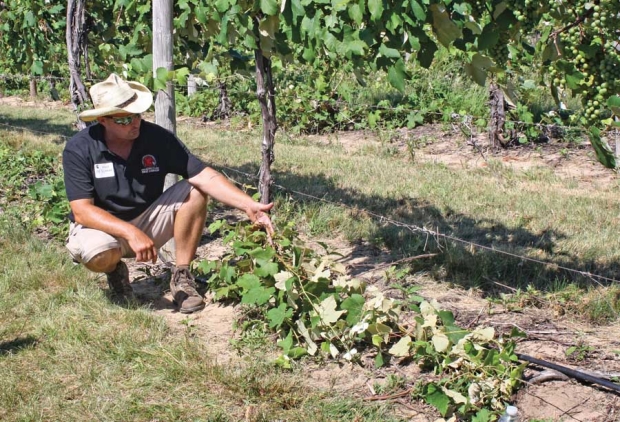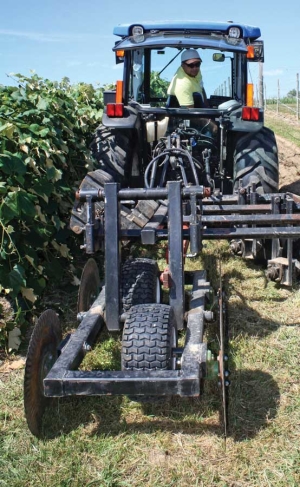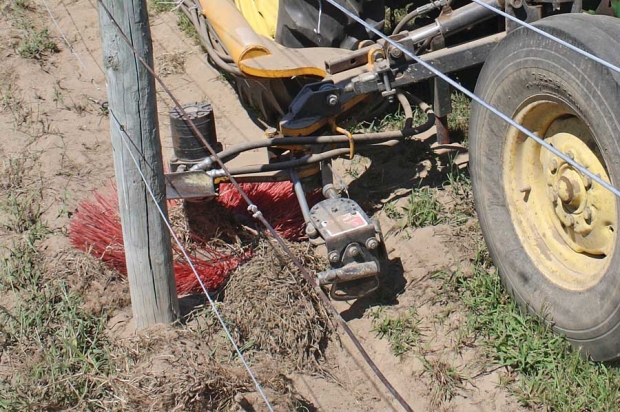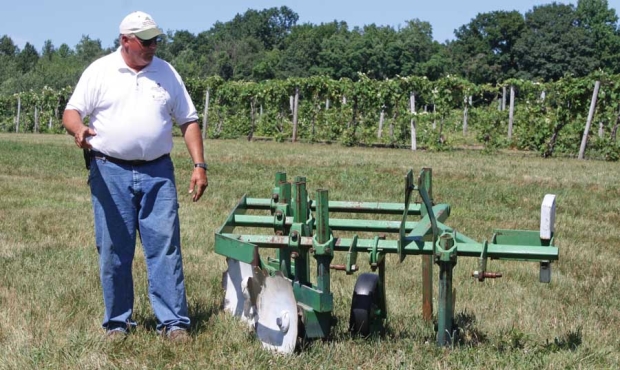
Mike de Schaaf grows an “insurance” cane that he lays down in the row and covers with soil to protect it and the graft union during winter. (Richard Lehnert/Good Fruit Grower)
Wine grape growers in Michigan have learned some lessons from the last two hard winters, which showed them in dramatic fashion which vinifera varieties can survive and where.
But growers are not sure exactly how to react. It’s been 20 years since the last destructive winter. Since then, local wineries have built wine styles and reputations based on varieties they don’t want to abandon. And no one knows what next winter will be like. We might have 20 more mild winters.

Erik Hurtado from Fenn Valley Winery uses this machine to cover a vine with soil and protect it from winter injury. (Richard Lehnert/Good Fruit Grower)
During Viticulture Day at the Southwest Michigan Research and Extension Center (SWMREC) in Benton Harbor, growers watched demonstrations showing how they can save the graft union and a replacement cane by burying them under soil or straw for the winter. They may not save mature trunks and cordons, but they can make a quick recovery from a devastating winter and have a crop that fall, growing on the renewal cane.
“A lot of growers in northern Michigan will do it this year,” said Duke Elsner, the viticulture specialist in the Grand Traverse Bay region, the most northerly of Michigan’s two wine growing regions.
“It’s insurance,” he said. “If the cordon survives, you cut the buried one off and throw it away. If it doesn’t, you train up the new one.”
The Viticulture Day demonstration was put on by Mike de Schaaf, a winegrape grower and the winemaker and vineyard manager at Lake Michigan Community College (and formerly owner and winemaker at Hickory Creek Winery); Erik Hurtado from Fenn Valley Winery; and Dr. Tom Zabadal and Dave Francis, who do wine grape research at Michigan State University’s SWMREC .
Zabadal noted that history was repeating itself, because he did some basic research on vine protection using burial back in 1995. Back then, growers were looking for ways to lock the barn after losing the horse the winter before. But after 20 years, most everybody who adopted the practice abandoned it after repeated and increasingly mild winters.
Zabadal found that burying the graft union and a cane growing from it under about five inches of soil would keep the vine temperature around 21°F. Three inches of packed straw (six inches loose straw) was not quite as effective, but temperatures under the straw stayed well above 0°F, even as air temperatures were reaching -18°F.
Mike de Schaaf grows grapes in the Lake Michigan Shore AVA and is president of the Michigan Grape Society, an association of growers. They maintain a lively Facebook page. He showed growers how the practice works during Viticulture Day and amplified on his remarks in a conversation with Good Fruit Grower.
During the growing season, a primary cane growing from above the scion union is allowed to grow up to the wire. In preparation for winter, in November or December, this cane is laid down along the row. It is then covered up, either with straw applied by a straw chopper or by a plow designed to turn soil up over the root and the prostrate cane.
The next spring, the buried cane is pulled back up before a tool, a rotating sweep brush, is used to claw back the straw or soil. That new cane will bear a crop, so the grower won’t miss a single harvest.
While it’s costly and time consuming, de Schaaf said, the alternative is to lose 100 percent of the crop for two years—and possibly lose the vine completely.

This tractor-mounted rotating brush is used to sweep mounded soil back into the row middle each spring. The buried vine is pulled up first. (Richard Lehnert/Good Fruit Grower)
“In Michigan and other colder climates, we promote the idea of leaving renewal spurs,” de Schaaf said. “So our vineyards look hairy and uncut compared to those in California.
Years ago, we would train a renewal cane to a low wire, thinking it might survive a winter buried under snow. But that interfered with weed control so we abandoned that practice.
“The idea now is to choose the best of the renewal canes and lay it down and bury it as an insurance policy. This is widely done in Europe.”
Some growers in Oregon use a similar method, digging a V-shaped trench and laying two canes in it and then covering them with soil.
“I grow Pinot Gris and Grüner Veltliner grapes,” de Schaaf said. “They are not as cold hardy as we thought they’d be, but they do come through spring freezes and bear a good crop on secondary buds, just as they do in Austria. I bury a cane from each vine every year now.”
He uses the soil burial method—he calls it hilling up—finding it cheaper than buying 125 small square bales of straw each fall. It takes a specialized tool to cover the cane. The brand he uses is made by Spedo, from Italy, but others are available. “Save a crop one time, and you’ve paid for the equipment,” he said. •

David Francis works at the research station and has developed this disk plow for hilling vines and covering an “insurance” cane.(Richard Lehnert/Good Fruit Grower)






Leave A Comment